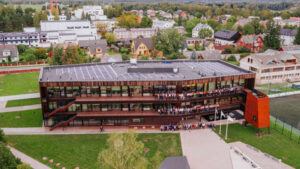Integrating e-Sustainability and Resilience into Low-cost and School Building Development
The document titled “Integrating e-Sustainability and Resilience into Low-Cost and School Building Development” explores strategies for enhancing the sustainability and resilience of school buildings in Turkey. It emphasizes the need for innovative approaches to design and construction that not only address environmental concerns but also improve educational outcomes.

Objectives of the Document
The primary objectives outlined in the document include:
- Promoting Sustainable Practices: Encouraging the use of environmentally friendly materials and technologies in school construction.
- Enhancing Resilience: Designing buildings that can withstand environmental stresses, such as floods, earthquakes, and extreme temperatures.
- Reducing Costs: Implementing low-cost solutions that do not compromise quality or safety.

Challenges to Implementation
Despite the potential benefits, several challenges hinder the integration of sustainability into school building development:
- Financial Constraints: Limited budgets often restrict investment in sustainable technologies, leading to a reliance on cheaper, less efficient solutions.
- Lack of Awareness: There is a general lack of understanding among stakeholders about the long-term benefits of sustainable building practices.
- Regulatory Barriers: Existing regulations may not adequately support innovative designs or sustainable materials.
Recommendations for Policy Improvement
To overcome these challenges, the document outlines several recommendations:
- Incentives for Sustainable Practices: The government should provide financial incentives or grants to encourage schools to adopt sustainable building practices.
- Training Programs: Offering training for architects, builders, and school administrators on sustainable design principles can enhance knowledge and implementation capabilities.
- Updating Regulations: Revising building codes to include sustainability criteria will facilitate the adoption of innovative practices in school construction.
Conclusion
In conclusion, integrating e-sustainability and resilience into low-cost school building development is essential for addressing Turkey’s educational infrastructure challenges. By adopting sustainable practices, utilizing innovative construction techniques, and engaging communities in the design process, Turkey can create schools that are not only environmentally friendly but also resilient to climate change impacts. The successful implementation of these strategies will lead to improved educational environments that enhance learning outcomes while contributing positively to the broader goals of sustainability and resilience in urban development. This approach aligns with global trends towards greener buildings and underscores Turkey’s commitment to fostering a more sustainable future for its educational institutions.
More reading: Implementing more sustainable building technologies to the Philippines
Sustainable School Design: Examples, Trends, and Tips in 2024 gbdmagazine
Today we’re building the sustainable schools of tomorrow
Sustainable and Climate-Ready Schools – Ten Strands tenstrands
